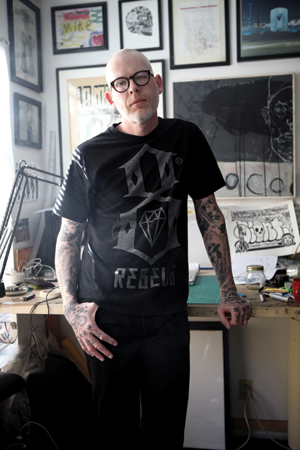Profession: Artist
Age: 40
Location: San Francisco, CA
How would you explain your artwork—what you do for a living and your street art background—to a bunch of Buddhists?
Well, I’m a product of my generation. I grew up through the 80s and was drawn to the punk rock and hip-hop cultures simultaneously. And I threw myself in headfirst. A lot of those things were about personal expression, and also an anti-establishment attitude like, “We don’t need you, we have our own thing.” That’s the backbone of who I am to this day.
I’ve been drawing since I could hold a pencil. I started skateboarding in 1983 and was fascinated by the graphics on the skateboards—I still am. And then I got into graffiti writing in 1989 just before I started college, and again, it was just expressive. I didn’t feel particularly like a criminal, and my parents didn’t really put that label on me either, which was really, really important. They were supportive of all of it. It just kind of evolved from there, and now at 40 years old I’m still skateboarding and still writing on walls and doing all that stuff. I found my middle ground, so to speak, in balancing that with my Buddhist understanding. I’m really trying to live the Eightfold Path as well as I can within this world and this society. And I feel like the livelihood that I have fits within that. Even in my artwork you’ll see a lot of little references to dharma, if you know what to look for.
Do you feel any tension between being involved in Buddhist culture and being part of the cultures of skateboarding, graffiti, and tattooing?
Yeah, I do feel a little out of place, to be honest with you. I wish there were more occasions where I was having conversations with people who were really developing the dharma in their own lives. I’m just not around that, because obviously in the world I run in there are a lot of criminals. Not to say that that’s a bad thing. It’s just that people cross the line. And I think Noah Levine points this out too, that Buddhist practice is revolutionary. It’s rebellious, especially in this day and age. There’s no denying that. Even just to say to a friend, “Hey, will you go up in the woods with me for a week and meditate?” They’re like, “What? You’re crazy.” I’m like, “Yeah, we won’t say a word.” And they’re like, “That’s even crazier.” That’s just how it is. I’m pretty out of touch.
It sounds like what you’re saying is that you feel like you need a sangha around you.
Oh, for sure. Thich Nhat Hanh really stressed the power of sangha. You have to surround yourself with good people. If you want to be a wise man, you need to surround yourself with wise men. You’re not going to get anywhere hanging out with the idiots, you know. You want to understand what a fine woman is about, you need to find a fine woman. You have to put the effort in, and you have to recognize when what you’re asking for is in front of you.
How much has Buddhist practice influenced the way that you create your art?
I would say that Buddhist practice has changed everything on a cellular level. It articulates in every single thing that I do. So for sure it’s influenced my artwork. I used to spend time drawing, and I might sit and ruminate and think and think and think and draw myself into depressive states even while I was drawing—which is usually the time when I feel happiest. I think my mind would drag me down. And then once I started to articulate mindfulness practice in everything I did, of course that moved into the artwork too. So now when I’m drawing—and it’s usually a good four to six hours a day—I’m practicing mindfulness. I’m listening to my thinking mind, and if I have a good idea I might make a note of it, and then I’ll come back to my breath and let things just calm down again and wait for the next thought.
Tell me about your tattoos.
The first time I saw a guy who had a full suit of tattoos, my jaw dropped and I was just, I want that. So now if I can drop that on people, I love to, because it really can be inspiring. I’m almost completely “suited,” meaning tattooed from head to toe. So that’s been a real powerful sense of accomplishment. And I do have a lot of dharma-related tattoos.
Like what?
I have the word “dukkha” backward along my collarbone, so when I look in the mirror, it’s the first thing I see below my neck. My whole back is a Mahakala, a Tibetan deity. On the back of my knee, I have the snake, the rooster, and the pig chasing each other around, from the wheel of existence in Tibetan iconography. I have a little 4, to remind me of the Four Noble Truths, and an 8, for the Eightfold Path. I have the words “impermanent vacation” across my thumbs, so when I sit in meditation with my hands a certain way, it’s what I see when I look down. And I have “True Love” on my knuckles, so when I turn my hands a different way, when I sit and look down, that’s what I see.
Thank you for subscribing to Tricycle! As a nonprofit, we depend on readers like you to keep Buddhist teachings and practices widely available.
